Page 1962 of 3419
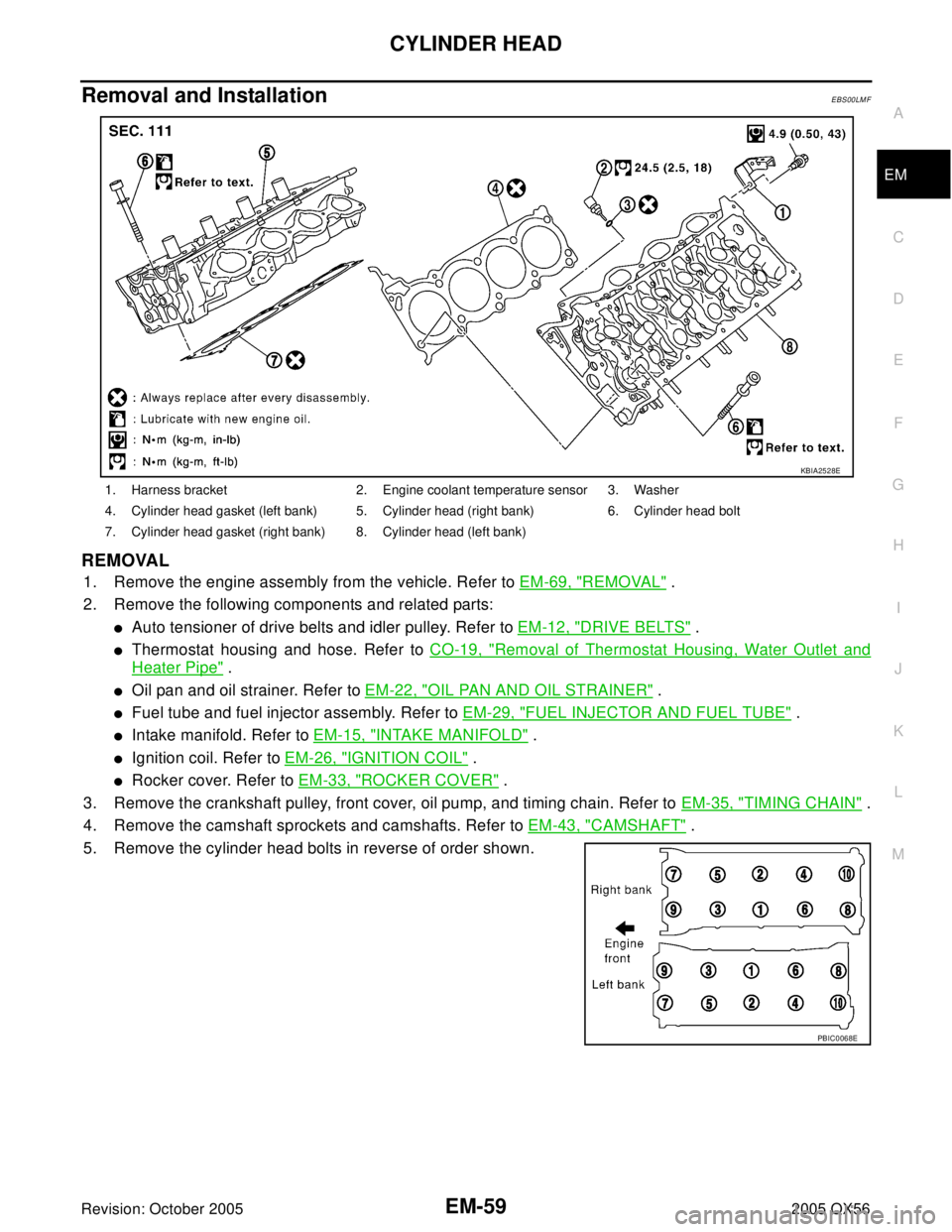
CYLINDER HEAD
EM-59
C
D
E
F
G
H
I
J
K
L
MA
EM
Revision: October 20052005 QX56
Removal and InstallationEBS00LMF
REMOVAL
1. Remove the engine assembly from the vehicle. Refer to EM-69, "REMOVAL" .
2. Remove the following components and related parts:
�Auto tensioner of drive belts and idler pulley. Refer to EM-12, "DRIVE BELTS" .
�Thermostat housing and hose. Refer to CO-19, "Removal of Thermostat Housing, Water Outlet and
Heater Pipe" .
�Oil pan and oil strainer. Refer to EM-22, "OIL PAN AND OIL STRAINER" .
�Fuel tube and fuel injector assembly. Refer to EM-29, "FUEL INJECTOR AND FUEL TUBE" .
�Intake manifold. Refer to EM-15, "INTAKE MANIFOLD" .
�Ignition coil. Refer to EM-26, "IGNITION COIL" .
�Rocker cover. Refer to EM-33, "ROCKER COVER" .
3. Remove the crankshaft pulley, front cover, oil pump, and timing chain. Refer to EM-35, "
TIMING CHAIN" .
4. Remove the camshaft sprockets and camshafts. Refer to EM-43, "
CAMSHAFT" .
5. Remove the cylinder head bolts in reverse of order shown.
1. Harness bracket 2. Engine coolant temperature sensor 3. Washer
4. Cylinder head gasket (left bank) 5. Cylinder head (right bank) 6. Cylinder head bolt
7. Cylinder head gasket (right bank) 8. Cylinder head (left bank)
KBIA2528E
PBIC0068E
Page 1972 of 3419
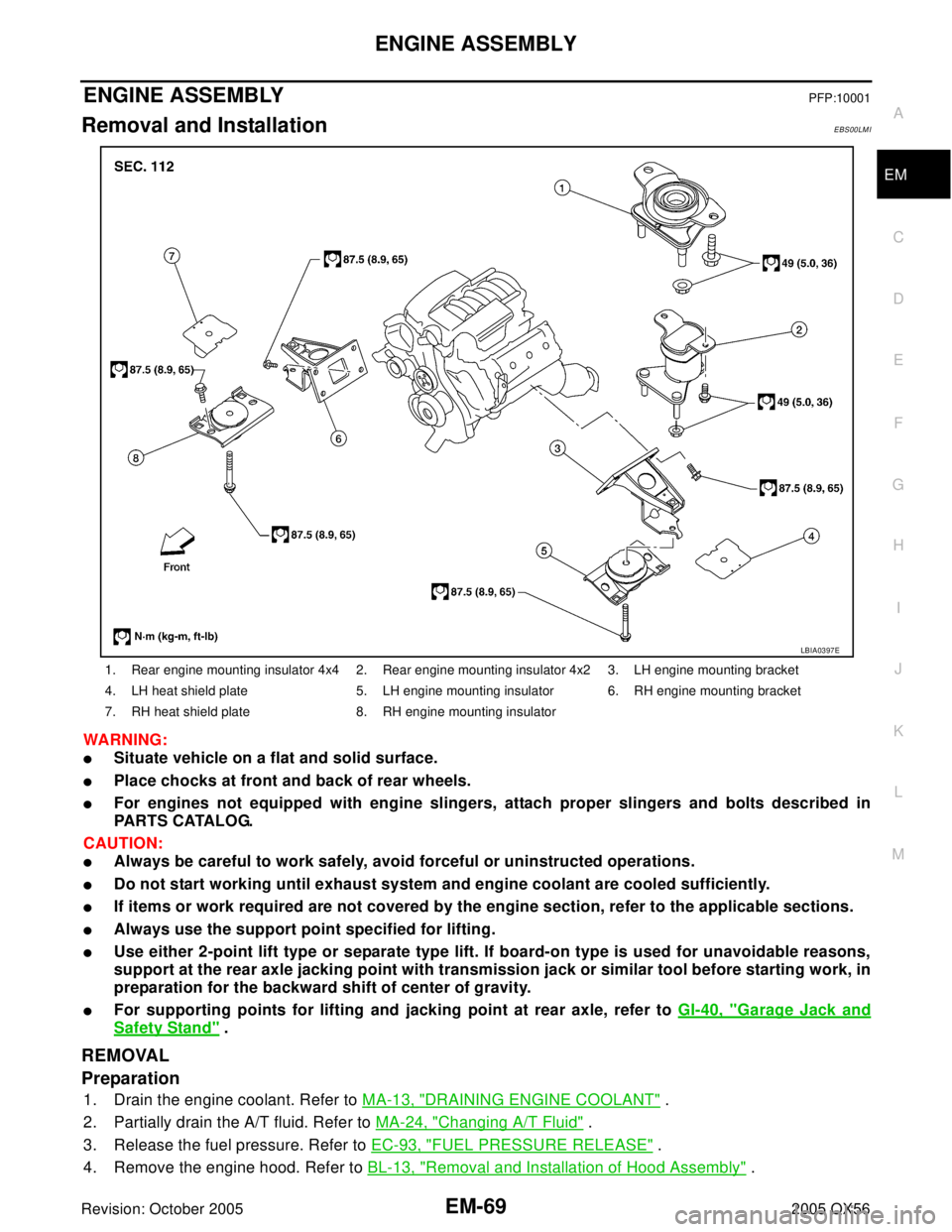
ENGINE ASSEMBLY
EM-69
C
D
E
F
G
H
I
J
K
L
MA
EM
Revision: October 20052005 QX56
ENGINE ASSEMBLYPFP:10001
Removal and InstallationEBS00LMI
WA RN ING:
�Situate vehicle on a flat and solid surface.
�Place chocks at front and back of rear wheels.
�For engines not equipped with engine slingers, attach proper slingers and bolts described in
PA R T S C ATA L O G.
CAUTION:
�Always be careful to work safely, avoid forceful or uninstructed operations.
�Do not start working until exhaust system and engine coolant are cooled sufficiently.
�If items or work required are not covered by the engine section, refer to the applicable sections.
�Always use the support point specified for lifting.
�Use either 2-point lift type or separate type lift. If board-on type is used for unavoidable reasons,
support at the rear axle jacking point with transmission jack or similar tool before starting work, in
preparation for the backward shift of center of gravity.
�For supporting points for lifting and jacking point at rear axle, refer to GI-40, "Garage Jack and
Safety Stand" .
REMOVAL
Preparation
1. Drain the engine coolant. Refer to MA-13, "DRAINING ENGINE COOLANT" .
2. Partially drain the A/T fluid. Refer to MA-24, "
Changing A/T Fluid" .
3. Release the fuel pressure. Refer to EC-93, "
FUEL PRESSURE RELEASE" .
4. Remove the engine hood. Refer to BL-13, "
Removal and Installation of Hood Assembly" .
1. Rear engine mounting insulator 4x4 2. Rear engine mounting insulator 4x2 3. LH engine mounting bracket
4. LH heat shield plate 5. LH engine mounting insulator 6. RH engine mounting bracket
7. RH heat shield plate 8. RH engine mounting insulator
LBIA0397E
Page 1973 of 3419
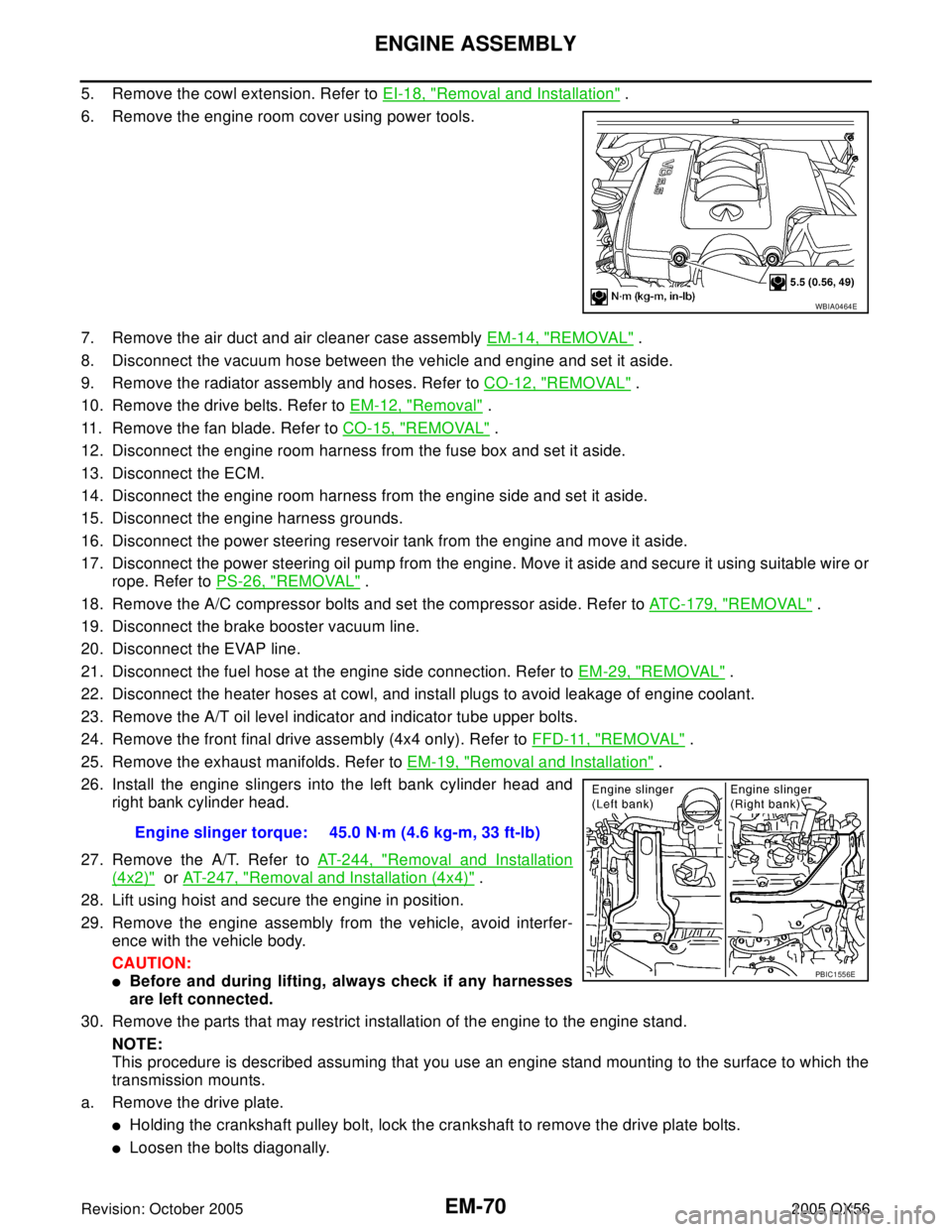
EM-70Revision: October 2005
ENGINE ASSEMBLY
2005 QX56
5. Remove the cowl extension. Refer to EI-18, "Removal and Installation" .
6. Remove the engine room cover using power tools.
7. Remove the air duct and air cleaner case assembly EM-14, "
REMOVAL" .
8. Disconnect the vacuum hose between the vehicle and engine and set it aside.
9. Remove the radiator assembly and hoses. Refer to CO-12, "
REMOVAL" .
10. Remove the drive belts. Refer to EM-12, "
Removal" .
11. Remove the fan blade. Refer to CO-15, "
REMOVAL" .
12. Disconnect the engine room harness from the fuse box and set it aside.
13. Disconnect the ECM.
14. Disconnect the engine room harness from the engine side and set it aside.
15. Disconnect the engine harness grounds.
16. Disconnect the power steering reservoir tank from the engine and move it aside.
17. Disconnect the power steering oil pump from the engine. Move it aside and secure it using suitable wire or
rope. Refer to PS-26, "
REMOVAL" .
18. Remove the A/C compressor bolts and set the compressor aside. Refer to ATC-179, "
REMOVAL" .
19. Disconnect the brake booster vacuum line.
20. Disconnect the EVAP line.
21. Disconnect the fuel hose at the engine side connection. Refer to EM-29, "
REMOVAL" .
22. Disconnect the heater hoses at cowl, and install plugs to avoid leakage of engine coolant.
23. Remove the A/T oil level indicator and indicator tube upper bolts.
24. Remove the front final drive assembly (4x4 only). Refer to FFD-11, "
REMOVAL" .
25. Remove the exhaust manifolds. Refer to EM-19, "
Removal and Installation" .
26. Install the engine slingers into the left bank cylinder head and
right bank cylinder head.
27. Remove the A/T. Refer to AT-244, "
Removal and Installation
(4x2)" or AT-247, "Removal and Installation (4x4)" .
28. Lift using hoist and secure the engine in position.
29. Remove the engine assembly from the vehicle, avoid interfer-
ence with the vehicle body.
CAUTION:
�Before and during lifting, always check if any harnesses
are left connected.
30. Remove the parts that may restrict installation of the engine to the engine stand.
NOTE:
This procedure is described assuming that you use an engine stand mounting to the surface to which the
transmission mounts.
a. Remove the drive plate.
�Holding the crankshaft pulley bolt, lock the crankshaft to remove the drive plate bolts.
�Loosen the bolts diagonally.
WBIA0464E
Engine slinger torque: 45.0 N·m (4.6 kg-m, 33 ft-lb)
PBIC1556E
Page 1974 of 3419
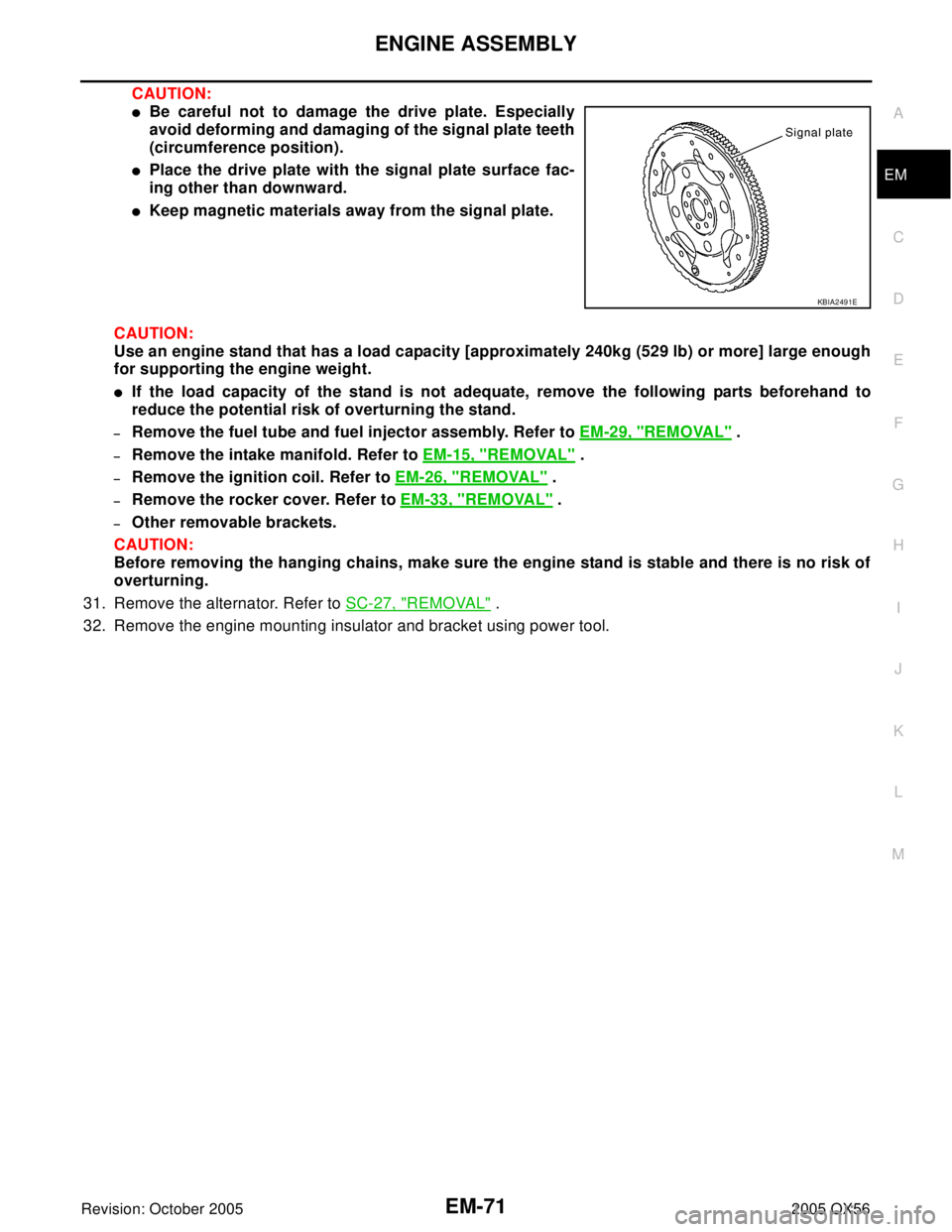
ENGINE ASSEMBLY
EM-71
C
D
E
F
G
H
I
J
K
L
MA
EM
Revision: October 20052005 QX56
CAUTION:
�Be careful not to damage the drive plate. Especially
avoid deforming and damaging of the signal plate teeth
(circumference position).
�Place the drive plate with the signal plate surface fac-
ing other than downward.
�Keep magnetic materials away from the signal plate.
CAUTION:
Use an engine stand that has a load capacity [approximately 240kg (529 lb) or more] large enough
for supporting the engine weight.
�If the load capacity of the stand is not adequate, remove the following parts beforehand to
reduce the potential risk of overturning the stand.
–Remove the fuel tube and fuel injector assembly. Refer to EM-29, "REMOVAL" .
–Remove the intake manifold. Refer to EM-15, "REMOVAL" .
–Remove the ignition coil. Refer to EM-26, "REMOVAL" .
–Remove the rocker cover. Refer to EM-33, "REMOVAL" .
–Other removable brackets.
CAUTION:
Before removing the hanging chains, make sure the engine stand is stable and there is no risk of
overturning.
31. Remove the alternator. Refer to SC-27, "
REMOVAL" .
32. Remove the engine mounting insulator and bracket using power tool.
KBIA2491E
Page 1975 of 3419
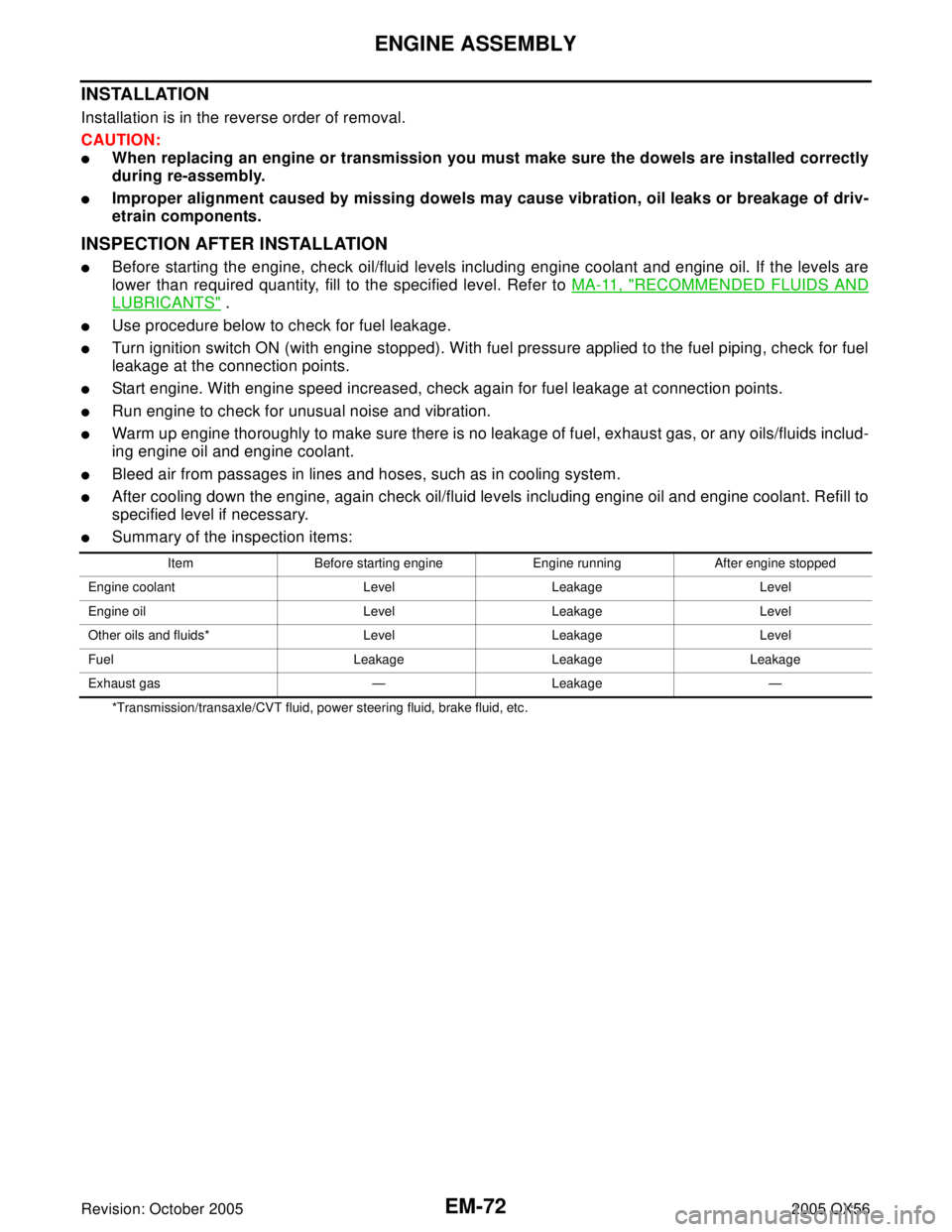
EM-72Revision: October 2005
ENGINE ASSEMBLY
2005 QX56
INSTALLATION
Installation is in the reverse order of removal.
CAUTION:
�When replacing an engine or transmission you must make sure the dowels are installed correctly
during re-assembly.
�Improper alignment caused by missing dowels may cause vibration, oil leaks or breakage of driv-
etrain components.
INSPECTION AFTER INSTALLATION
�Before starting the engine, check oil/fluid levels including engine coolant and engine oil. If the levels are
lower than required quantity, fill to the specified level. Refer to MA-11, "
RECOMMENDED FLUIDS AND
LUBRICANTS" .
�Use procedure below to check for fuel leakage.
�Turn ignition switch ON (with engine stopped). With fuel pressure applied to the fuel piping, check for fuel
leakage at the connection points.
�Start engine. With engine speed increased, check again for fuel leakage at connection points.
�Run engine to check for unusual noise and vibration.
�Warm up engine thoroughly to make sure there is no leakage of fuel, exhaust gas, or any oils/fluids includ-
ing engine oil and engine coolant.
�Bleed air from passages in lines and hoses, such as in cooling system.
�After cooling down the engine, again check oil/fluid levels including engine oil and engine coolant. Refill to
specified level if necessary.
�Summary of the inspection items:
*Transmission/transaxle/CVT fluid, power steering fluid, brake fluid, etc.Item Before starting engine Engine running After engine stopped
Engine coolant Level Leakage Level
Engine oil Level Leakage Level
Other oils and fluids* Level Leakage Level
Fuel Leakage Leakage Leakage
Exhaust gas — Leakage —
Page 2066 of 3419
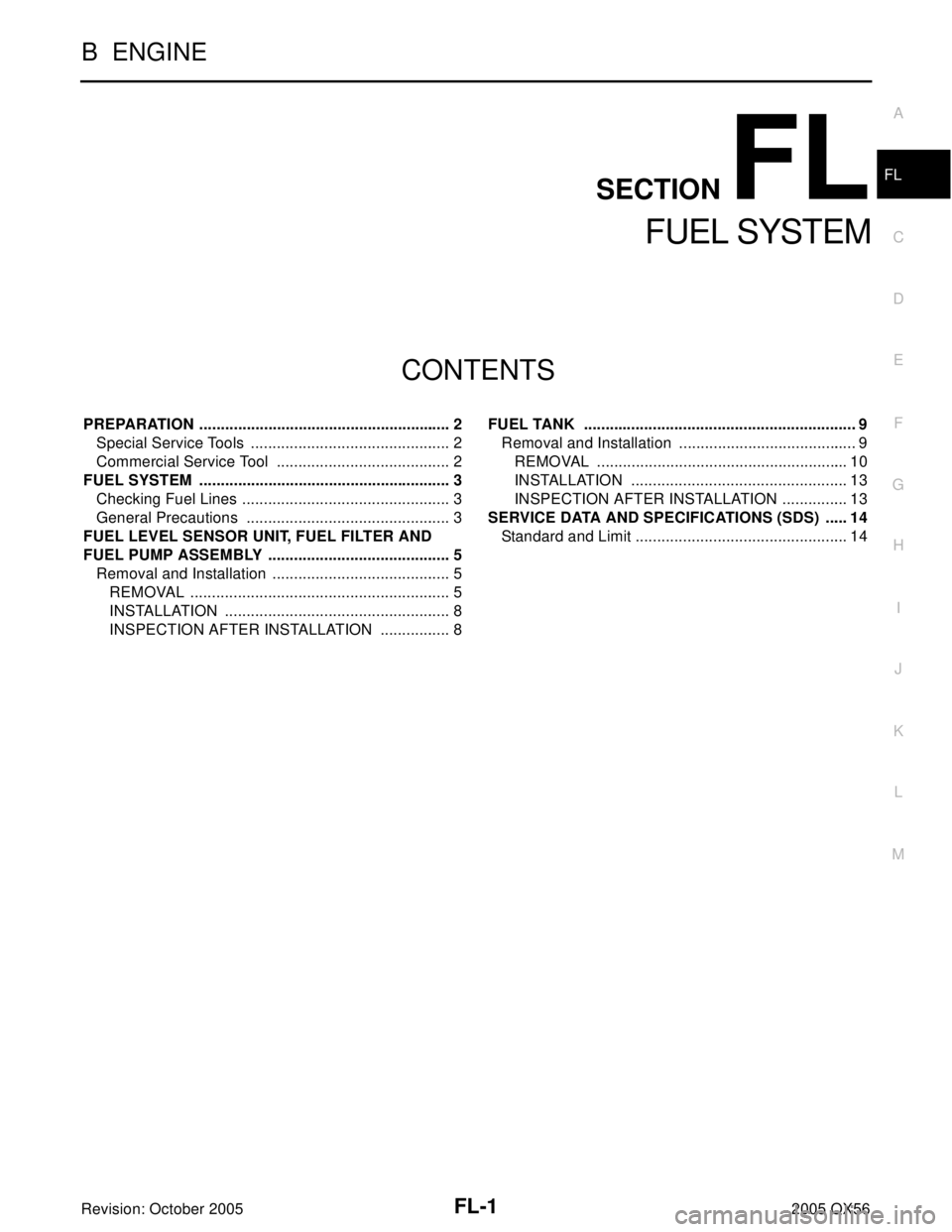
FL-1
FUEL SYSTEM
B ENGINE
CONTENTS
C
D
E
F
G
H
I
J
K
L
M
SECTION FL
A
FL
Revision: October 20052005 QX56 PREPARATION ........................................................... 2
Special Service Tools ............................................... 2
Commercial Service Tool ......................................... 2
FUEL SYSTEM ........................................................... 3
Checking Fuel Lines ................................................. 3
General Precautions ................................................ 3
FUEL LEVEL SENSOR UNIT, FUEL FILTER AND
FUEL PUMP ASSEMBLY ........................................... 5
Removal and Installation .......................................... 5
REMOVAL ............................................................. 5
INSTALLATION ..................................................... 8
INSPECTION AFTER INSTALLATION ................. 8FUEL TANK ................................................................ 9
Removal and Installation .......................................... 9
REMOVAL ........................................................... 10
INSTALLATION ................................................... 13
INSPECTION AFTER INSTALLATION ................ 13
SERVICE DATA AND SPECIFICATIONS (SDS) ...... 14
Standard and Limit .................................................. 14
Page 2067 of 3419
FL-2Revision: October 2005
PREPARATION
2005 QX56
PREPARATIONPFP:00002
Special Service ToolsEBS00M 3O
The actual shapes of the Kent-Moore tools may differ from those of the special tools illustrated here.
Commercial Service ToolEBS00M3P
Tool number
(Kent-Moore No.)
Tool nameDescription
—
(J-46536)
Fuel tank lock ring toolRemoving and installing fuel tank lock ring
LBIA0398E
Tool nameDescription
Power toolLoosening bolts and nuts
PBIC0190E
Page 2068 of 3419
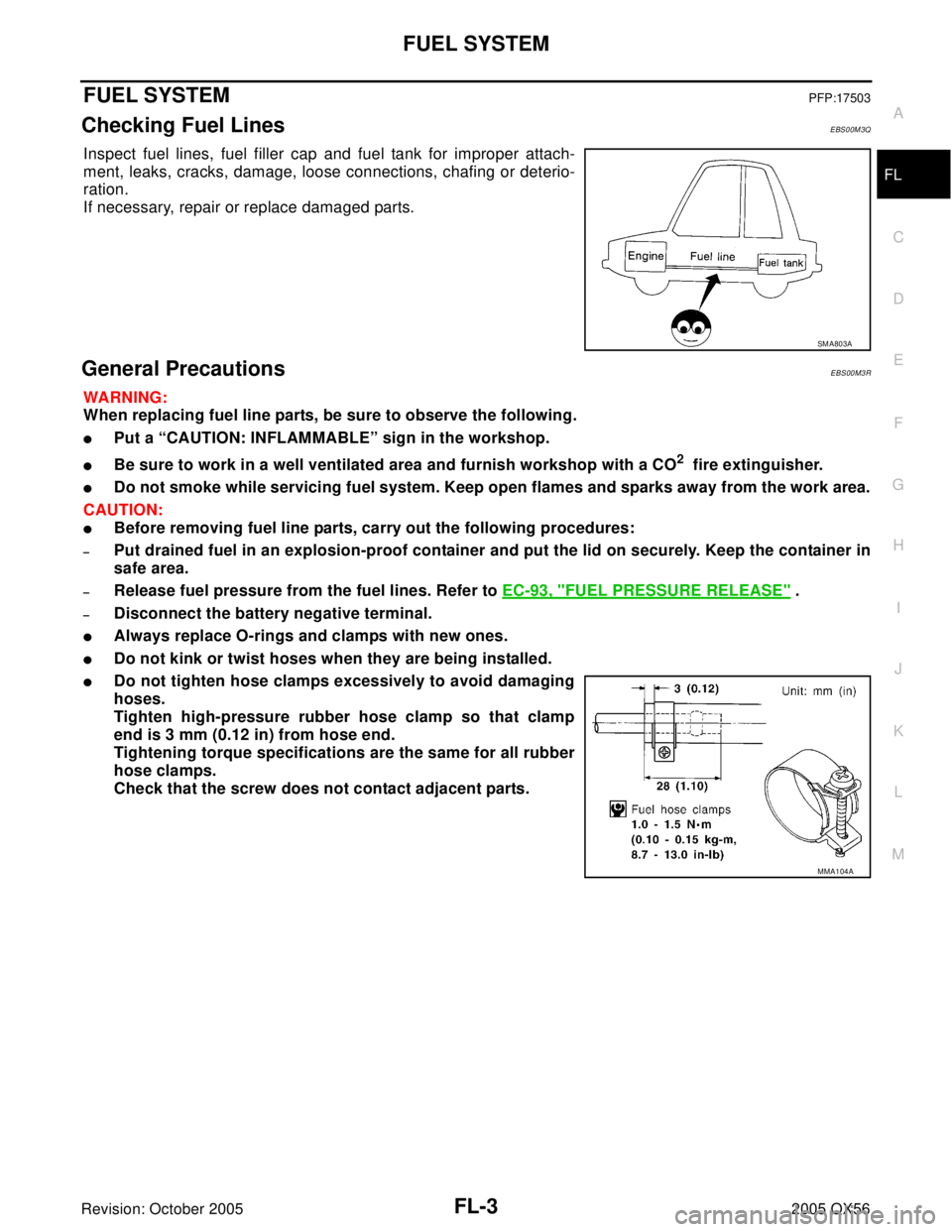
FUEL SYSTEM
FL-3
C
D
E
F
G
H
I
J
K
L
MA
FL
Revision: October 20052005 QX56
FUEL SYSTEMPFP:17503
Checking Fuel LinesEBS00M3Q
Inspect fuel lines, fuel filler cap and fuel tank for improper attach-
ment, leaks, cracks, damage, loose connections, chafing or deterio-
ration.
If necessary, repair or replace damaged parts.
General PrecautionsEBS00M3R
WA RN ING:
When replacing fuel line parts, be sure to observe the following.
�Put a “CAUTION: INFLAMMABLE” sign in the workshop.
�Be sure to work in a well ventilated area and furnish workshop with a CO2 fire extinguisher.
�Do not smoke while servicing fuel system. Keep open flames and sparks away from the work area.
CAUTION:
�Before removing fuel line parts, carry out the following procedures:
–Put drained fuel in an explosion-proof container and put the lid on securely. Keep the container in
safe area.
–Release fuel pressure from the fuel lines. Refer to EC-93, "FUEL PRESSURE RELEASE" .
–Disconnect the battery negative terminal.
�Always replace O-rings and clamps with new ones.
�Do not kink or twist hoses when they are being installed.
�Do not tighten hose clamps excessively to avoid damaging
hoses.
Tighten high-pressure rubber hose clamp so that clamp
end is 3 mm (0.12 in) from hose end.
Tightening torque specifications are the same for all rubber
hose clamps.
Check that the screw does not contact adjacent parts.
SM A80 3A
MMA104A